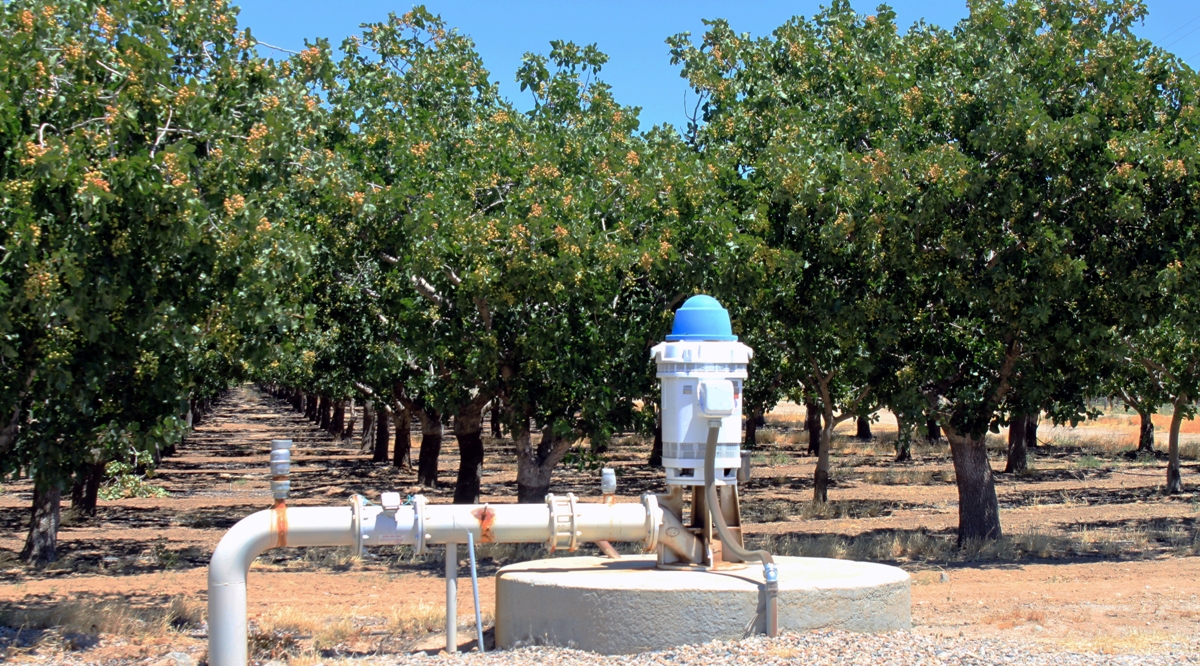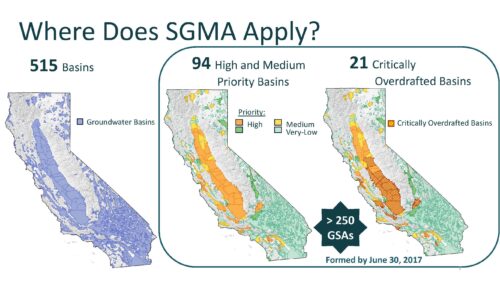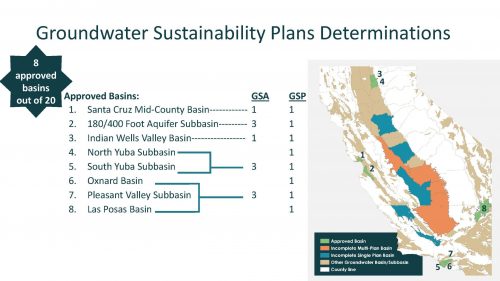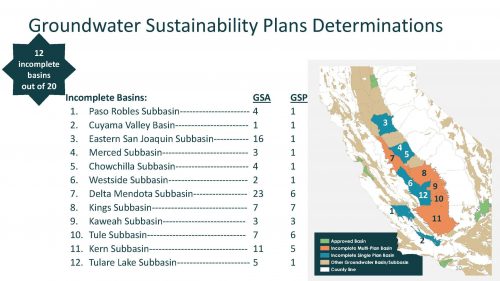In January of 2022, the Department of Water Resources (DWR) released their assessments of the groundwater sustainability plans for the critically overdrafted groundwater basins, approving eight of them and determining twelve to be incomplete. Those basins have until July 31, 2022 to correct the deficiencies and resubmit their plans to DWR or face possible intervention by the State Water Resources Control Board.
At the May 10 meeting of the State Water Board, James Nachbaur and Anthony Wohletz from the State Water Board’s Office of Research, Planning, and Performance, and Paul Gosselin, Deputy Director of Sustainable Groundwater Management, updated the Board members on the status of SGMA implementation and the what the possible future role of State Water Board’s intervention would look like.
SGMA basics, briefly
James Nachbaur began by reminding that groundwater is a critical resource; about 80% of people in California use or rely to some degree on groundwater. Reliance on groundwater increases substantially during drought.
The Sustainable Groundwater Management Act (or SGMA) was passed in 2014 at a time when the state was experiencing a severe drought and groundwater basins were being depleted. On the day the Act was signed, almost all of California was in exceptional, extreme, or severe drought.
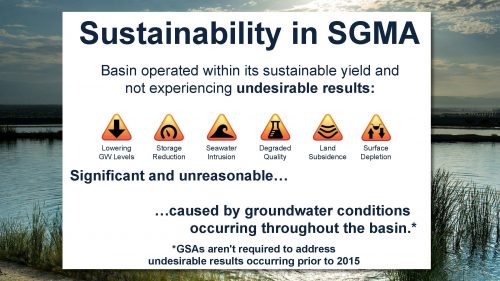 SGMA applies to alluvial groundwater basins and subbasins designated by the Department of Water Resources as high or medium priority. The legislation defines sustainable groundwater management as avoiding these six undesirable results:
SGMA applies to alluvial groundwater basins and subbasins designated by the Department of Water Resources as high or medium priority. The legislation defines sustainable groundwater management as avoiding these six undesirable results:
- Low groundwater levels: This was a problem in 2014 as many drinking water wells and production wells were going dry.
- Reduced groundwater storage: There was concern that the heavy pumping during the drought was depleting reservoirs, leaving little left as a reserve for communities and agriculture to withstand future dry periods.
- Seawater intrusion: Pumping near the coast was pulling in seawater in some cases and making wells less usable.
- Water quality degradation: as water levels drop, the concentrations of pollutants can increase.
- Land subsidence: Groundwater pumping can cause the land surface to drop unevenly, damaging infrastructure such as roads and canals, which are costly to repair.
- Depletion of surface water that interacts with groundwater: Pumping was reducing flow levels and rivers and streams. And this was impacting other groundwater users downstream, including the environment.
Mr. Nachbaur noted that the legislation looks to maintain or attain conditions as they were in 2015; it does not require remediating groundwater conditions to go back further in time. SGMA sets a timeline of 20 years to achieve sustainability.
The first step of SGMA implementation was for each groundwater basin or subbasin to form a Groundwater Sustainability Agency (GSA) by June 30, 2017. This was very successful, with 99% forming GSAs.
The next step was to develop groundwater sustainability plans that detail the basin or subbasin’s path to achieve sustainability. Those basins or subbasins determined to be critically overdrafted were required to submit their groundwater sustainability plans to the Department of Water Resources by January 31, 2020; the remaining basins and subbasins had until January 31, 2022, to submit their plans. Implementation is already underway.
Mr. Gosselin noted that although there have been a lot of requirements so far, the program is still in the early stages. “There’s a long path from here to 2040 and 2042,” he said. “It’s a new statute that changed 100 years of water law. Not knowing how all those mechanisms would unfold, especially with the relationship with the three pillars being Department of Water Resources, State Water Board, and local groundwater sustainability agencies, I think that so far, it has been working very well.”
“As we look forward to how this unfolds, there are obviously a lot of challenges ahead and a lot of uncertainty,” he continued. “With the partnership with DWR and the State Board, I’m very confident that we’ll be able to continue our work with local agency stakeholders and really have a successful program so we can look at groundwater sustainability as a reality in 2040 and 2042.”
DWR’s regulatory oversight
The graphic below shows the regulatory pathways. Once plans are submitted, the Department has two years to review them. When the plans are submitted, they have been adopted by the governing board of the GSA, so they immediately become implementable.
“They are implementing them upon adoption,” said Mr. Gosselin. “They don’t wait for our review and approval.”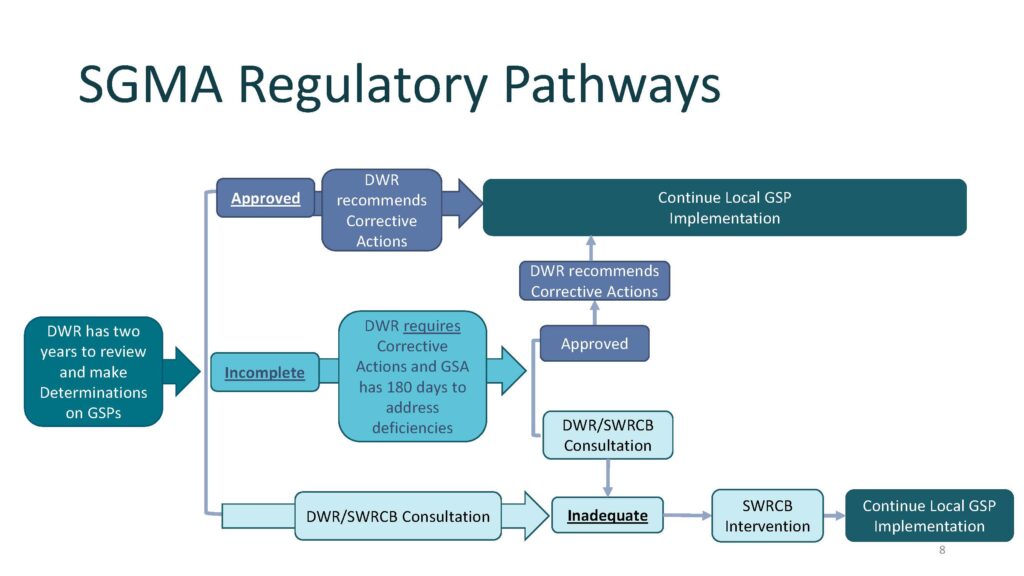
He noted that DWR limited the review to what was submitted at the time. “As local agencies start to make changes and adapt, we would never get through that if we were chasing around changes to plan,” he said. “So it was what was submitted at the time, knowing that some plans had changed by the time we completed review, but our review is looking at ‘substantial compliance’ with the law. We’re not deeming plans to be perfect because they will be adaptable. And we are going to expect them to change over time as circumstances change.”
The review looked to see if the plan was on track to achieve sustainability in 20 years and considered all groundwater users and uses, a fundamental facet of the law. Those that did meet substantial compliance with the law were approved, acknowledging that there are likely issues, uncertainties, and data gaps and will need changes; the Department provided recommended corrective actions and will look for changes in the five-year update.
If the plan has deficiencies that preclude the Department from determining substantial compliance, the Department can deem the plan incomplete. The Department provides a written determination of what those deficiencies are, and under the regulations, they have 180 days (6 months) to reconcile and correct those deficiencies. The Department is in communication with the GSAs to provide guidance so the deficiencies can be corrected by the end of July. Ultimately, if not corrected, the plan can be deemed inadequate and potentially be subject to intervention by the State Water Board.
Throughout this process, the local agencies are implementing their plans. The Department recently issued grants to many of the basins whose plans were deemed inadequate as there’s a lot of work to do, and the hard work of moving towards sustainability will continue.
“It may mean that the goal line they’re going for may just need to change a little bit, but if they’re on the right track through either demand reduction or supply augmentation to recharge, they’re going to continue with those,” said Mr. Gosselin.
Out of the plans submitted for twenty critically overdrafted basins, eight were found to be substantially compliant and twelve were deemed incomplete.
“For the agencies that had to submit a plan by 2020, it was quite the daunting task with a new law, a new set of regulations, and a lot of work ahead,” he said.
Mr. Gosselin noted that these agencies are trying to resolve the deficiencies, but it can be complicated when multiple member agencies are involved with logistics, noticing, and approvals. He noted that the Department is advising the agencies that it’s better to get the deficiencies corrected, even if it means missing the deadline because if the deficiencies aren’t addressed, the plan could be deemed inadequate and sent to the State Board for possible intervention.
Common deficiencies
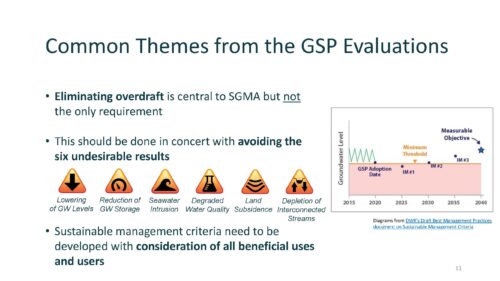 Many agencies did a lot of work to stop the overdraft in the basin by 2040 or 2042, and Mr. Gosselin acknowledged that’s important. “But the main change in water management that SGMA called for was to take into account how that affects groundwater uses and uses and answering the sustainability question; it’s not what you’re aspiring to do, but what you want to avoid.”
Many agencies did a lot of work to stop the overdraft in the basin by 2040 or 2042, and Mr. Gosselin acknowledged that’s important. “But the main change in water management that SGMA called for was to take into account how that affects groundwater uses and uses and answering the sustainability question; it’s not what you’re aspiring to do, but what you want to avoid.”
“Many of the plans lacked the detailed analysis on where the basin was going to be in 2040, and how that affects groundwater users and uses, such as shallow domestic wells or subsidence on the impact on infrastructure,” he continued. “Some lacked details, and some needed more analysis to explain specifically where the minimum threshold was set, which is the point where undesirable results are starting to occur. And so the analysis seemed to be lacking, and there wasn’t the explanation or analysis that groundwater uses and users were not going to have undesirable results.”
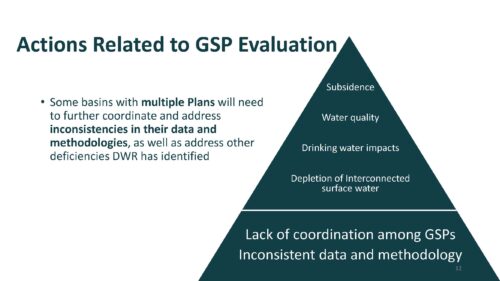 The pyramid shows some of the common themes that cut across the deficiencies in the 12 plans.
The pyramid shows some of the common themes that cut across the deficiencies in the 12 plans.
Addressing subsidence is a challenge; many of the plans that did address subsidence largely lacked the quantification of the infrastructures were of concern and their capacity to withstand subsidence.
“We did point out in our notices that SGMA did call for agencies to minimize or eliminate subsidence,” he said. “Some had some continued rates of subsidence that they’re looking now to address and become substantially compliant with the regulations.”
Water quality was another issue; some of the plans lacked the details and understanding of the water quality issues occurring in their basin and how they interface with the other lead agencies on water quality. Also, some agencies submitted plans that would bring their basin down below historic lows, which Mr. Gosselin said they’re allowed to do, provided that they consider how they address groundwater uses and users.
“When the basin is drawn down below historic lows, one of the things we wanted them to take was a heightened oversight and look at water quality issues because it may exacerbate water quality issues within the basin,” he said. “Also, when they do projects such as recharge, they understand where those water quality issues are so they don’t exacerbate those impacts.”
Drinking water impacts was another significant deficiency. “Looking out at 2040-2042, there were a number of shallow domestic wells and even community wells that looked like they would be dry because the minimum thresholds were above or below where those wells were screened,” he said. “Mitigation is not required in the statute, but addressing how the minimum thresholds address groundwater uses and users and whether the undesirable results is the requirement. So the question back to the agencies was, if there was any number of wells – even one well – that under the management of that basin was going to go dry, they needed to explain how that’s not an undesirable result for those users of groundwater.”
Mr. Gosselin acknowledged there’s a lot of uncertainty about the well database; it includes a lot of wells that probably are not in use. “Some agencies tried to remove the 5 or 10% of the most shallow outliers, but that will have to be refined. They have to address upfront how the sustainable management criteria address groundwater uses and users and avoid undesirable results.”
Depletion of interconnected surface waters was another key area where the Department found deficiencies. He acknowledged that a good methodology for monitoring and managing interconnected surface waters hasn’t been developed yet.
“We’re developing that; a lot of agencies are working collaboratively and regions to look at that,” he said. “The law did preclude the state board from intervening on this indicator alone until 2025. Part of that was recognizing that this was a real uncertainty on how to develop a methodology to deal with interconnected surface waters.”
Many agencies identified this as a data gap, and some didn’t address it at all. “In all cases, we told them that we needed specific minimum thresholds by 2025 addressing depletion of interconnected surface waters,” he said.
Two basins submitted multiple GSPs within their basins, which is allowed, but the plans must rely on the same data and methodologies. “The intent was that if agencies did have multiple plans, the accumulation of those plans need to walk and talk about the basin in the same way apples to apples so we and the public can view how those plans are in a coordinated way that addresses and lead towards sustainability.”
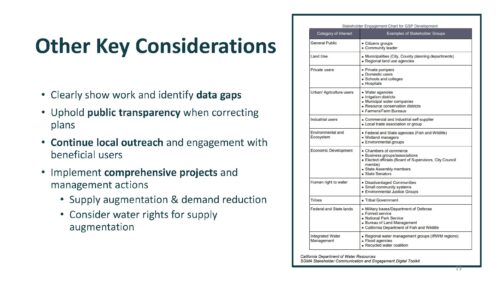 Many of the plans identified data gaps; having a path forward to fill data gaps is important. Public transparency is also important, particularly local outreach; the Department will continue to work with the local agencies to improve community outreach and engagement.
Many of the plans identified data gaps; having a path forward to fill data gaps is important. Public transparency is also important, particularly local outreach; the Department will continue to work with the local agencies to improve community outreach and engagement.
The Department also reviewed the list of projects for supply augmentation and demand reduction, although Mr. Gosselin acknowledged that not all of these projects may be feasible or be funded, and the approaches that the GSAs need to take over the next 20 years may need to change.
“We really wanted just to make sure that they had enough plans to carry this out,” said Mr. Gosselin. “We’ll be working closely with them every five years, making sure they’re on track with their interim measures and how those projects and management actions are taking hold.”
2022 Groundwater sustainability plans and alternative evaluations
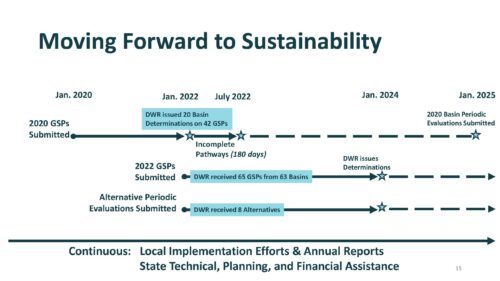 The work reviewing plans at the Department of Water Resources continues as the remaining medium and high priority basins submitted their GSPs to the Department as required by January 31, 2022. The Department received 65 GSPs from 63 basins, as well as four plans from low priority basins that were voluntarily submitted.
The work reviewing plans at the Department of Water Resources continues as the remaining medium and high priority basins submitted their GSPs to the Department as required by January 31, 2022. The Department received 65 GSPs from 63 basins, as well as four plans from low priority basins that were voluntarily submitted.
The alternative periodic evaluations were also due in January, and all GSAs must submit annual reports by April 1. All of this information is available on the DWR portal: Click here for the SGMA portal.
“We do have continuous oversight of plan implementation, so if at any time, if we find plans going sideways, and they’re not implementing it for whatever reason, we’ll engage with them, which could lead to an inadequate plan and result in board intervention after consultation,” said Mr. Gosselin.
DWR’s groundwater assistance
Besides their oversight role, DWR has invested $54 million in technical assistance to date. “The Department is working closely and helping to guide local agencies towards sustainability because that’s really at our heart and soul, at the end of the day,” said Mr. Gosselin. “It’s really making sure that at the local level, the agencies have the tools, information, and resources to work within their communities to get to sustainability.”
He briefly reviewed the different types of assistance available from DWR.
- Groundwater Data and Tools: DWR has many resources to assist GSAs in managing groundwater resources, including datasets, tools, and online visualization platforms. A video highlighting the datasets and tools available is available here: Click here to watch the webinar
- Groundwater Live is DWR’s newest groundwater tool, which features the latest information, live statistics, and interactive dashboards. Click here to visit Groundwater Live.
- Land Subsidence Data: Information on land subsidence in California based on DWR’s Interferometric Synthetic Aperture Radar (InSAR) remote sensing and continuous global positioning system (CGPS) station datasets are available from DWR. Visit Groundwater Live to explore two interactive and user-friendly dashboards and find out where land subsidence is currently occurring and how it has changed over time in California. Click here to visit Groundwater Live’s subsidence information.
- Airborne Electromagnetic (AEM) Surveys: DWR’s AEM project, when completed, will have all the major groundwater basins in the state mapped. This will provide state and federal agencies, groundwater sustainability agencies (GSAs), stakeholders, and the public with basin-specific and cross-basin geophysical data, tools, and analyses. Find out more on DWR’s AEM webpage.
- Monitoring well installation and borehole camera surveys: DWR’s technical services include monitoring well installation, geophysical logging, groundwater level monitoring training, borehole video logging, and other field activities. To learn more, visit this page, scroll down, and select the technical services tab.
- New Efforts on Accounting & Water Trading: The Department has been working with the California Water Data Consortium on accounting platforms to provide tools for the local agencies who want to implement groundwater trading. Click here for more information.
- Planning Assistance: Each basin has a point of contact at DWR’s regional offices, which has been helpful for local knowledge and guidance.
- Outreach materials: Guidebooks have been developed for engaging with Tribal governments, stakeholder communication and engagement, and underrepresented groundwater users. Guidance for addressing drinking water and domestic wells is under development, and other guidance documents are under consideration.
- Facilitation Support Services: The Department provides professional facilitation support services for GSAs at no cost to help foster discussions among diverse water management interests and local agencies. Click here and scroll down to the Facilitation Support tab.
- Written translation services: The Department can provide written translation services in eight different languages – not only Spanish but Hmong, Punjabi, and more. The Department is also looking at piloting verbal translation services for local agencies to help communities better engage their local agencies. Click here and scroll down to the Written Translation tab
- Funding and financial assistance: The Department will be issuing $350 million over the next three years for SGMA implementation. This year, there will be $100 million for recharge projects. Click here for more information.
- Coordination with other agencies and organizations: The Department has also been working with the Department of Conservation on the Multibenefit Land Repurposing Program and the Sustainable Ag Lands Conservation Program and the Department of Food and Ag on the Statewide Water Efficiency Program (SWEEP), and the Healthy Soils initiative. GoBiz has been a strong partner with the Department and local agencies to help with community development and workforce development programs as they transition to groundwater sustainability.
State Water Board intervention
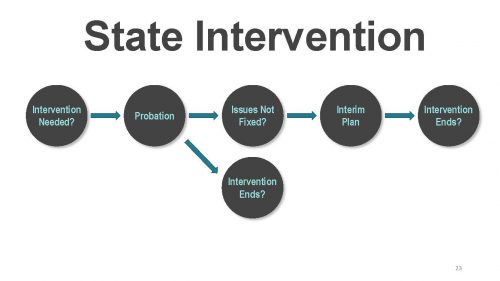 Next, Anthony Wohletz, a senior engineering geologist with the State Water Board’s groundwater management program, then discussed state intervention, which is the primary role of the State Water Board under SGMA.
Next, Anthony Wohletz, a senior engineering geologist with the State Water Board’s groundwater management program, then discussed state intervention, which is the primary role of the State Water Board under SGMA.
So far, the Board has not had to intervene, as SGMA implementation has been successful. So the Board has focused its efforts on general support, helping GSAs and stakeholders with facilitation, technical assistance, and outreach. The Board has worked with DWR as they review plans and has submitted public comments on plans focused on drinking water, water quality, and water rights.
However, the statute is clear: If the GSA is not managing its groundwater sustainably, the state needs to step in to protect the resource until the GSA can manage the groundwater basin sustainably. That is done through a process called state intervention.
There are two main phases to state intervention:
In the first phase, the board can place a basin on probation and hopefully solve the problems. If issues cannot be fixed during probation, then the state can move to the second base in which it implements an interim plan. Both of these phases provide tools for the Board to help basins get back on track. The intervention process can end at any time once the GSA can manage the basin sustainably.
Mr. Wohletz then went into more detail on the phases.
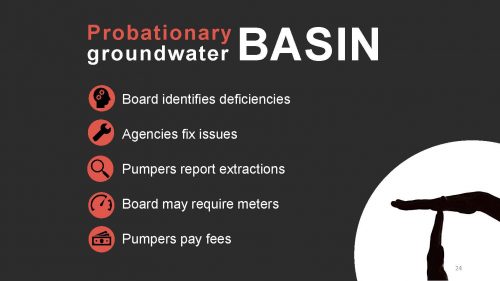 The first phase is probation. The board identifies deficiencies and then works with agencies to help agencies fix the deficiencies. The board also collects data to understand groundwater conditions to better help basins. Pumpers of groundwater report their extractions to the board, and the board can order investigations.
The first phase is probation. The board identifies deficiencies and then works with agencies to help agencies fix the deficiencies. The board also collects data to understand groundwater conditions to better help basins. Pumpers of groundwater report their extractions to the board, and the board can order investigations.
The board may require meters for groundwater pumpers to ensure that the data are high quality. And importantly, the statute requires that pumpers pay fees on their extractions for the board to recover its programmatic costs.
Hopefully, issues can be fixed during probation, and intervention can end. But if not, then the Board may move on to the second phase of intervention in which the Board implements an interim plan.
“An interim plan provides the Board the authority to limit groundwater pumping,” said Mr. Wohletz. “An interim plan is temporary. It is, like probation, meant to be a temporary tool that we use to help get a basin back on track so that it can resume local management. It’s also not meant to replace a GSP. Local agencies continue to implement their GSPs, and so they continue to make progress on implementing their projects and management actions.”
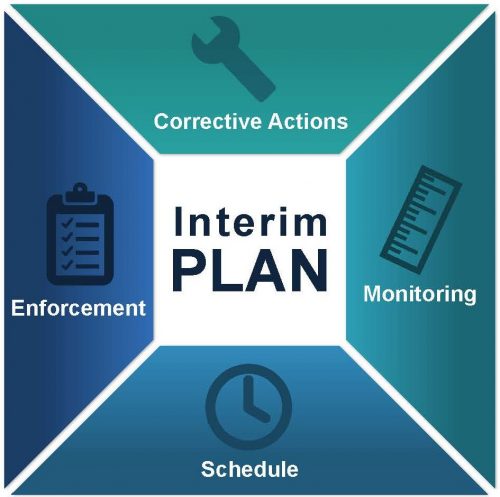 The interim plan has four main components:
The interim plan has four main components:
- Corrective actions, both physical solutions (infrastructure) and demand management (pumping restrictions);
- monitoring;
- enforcement; and
- schedule.
“Because this is an interim temporary plan, and because GSAs will continue to implement their GSPs while this is happening, the board will likely lean more heavily on demand management – corrective actions like groundwater pumping restrictions,” said Mr. Wohletz. “There are monitoring components to track how well corrective actions are working. There’s a schedule component for implementing corrective actions. And there’s an enforcement component to ensure that corrective actions are being implemented.”
Timeline for intervention
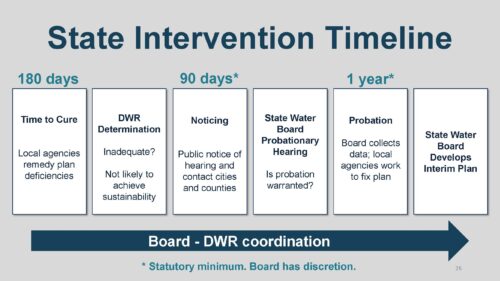 The slide shows the timeline for intervention. There are 12 basins whose plans were incomplete; those revised plans are due back to DWR at the end of July. At that time, if a plan is found to be inadequate, then the Board may consider placing the basin on probation.
The slide shows the timeline for intervention. There are 12 basins whose plans were incomplete; those revised plans are due back to DWR at the end of July. At that time, if a plan is found to be inadequate, then the Board may consider placing the basin on probation.
Placing a basin into probation requires a probationary hearing and at least 90 days of noticing before that probationary hearing occurs.
“If the board decides to take a basin into probation, we move into that first phase of the intervention,” said Mr. Wohletz. “The board works with basins and tries to help correct deficiencies. And if problems can’t be fixed after at least one year, the board can consider moving into the second phase where it implements an interim plan.”
“Intervention is something that we haven’t had to do yet because things have been relatively successful. But it’s something we might have to start soon potentially doing, depending on what happens with DWR assessments of these plans.”
QUESTIONS AND ANSWERS
QUESTION: Board member Laurel Firestone had a question about whether the 12 basins that may potentially be coming to the board, do they have reporting metering requirements?
Paul Gosselin: “During their annual reports, they will have to submit estimated pumping within the basin. And they can do that in various ways: through ET, through their groundwater model, or through metering. But in terms of what the board would do under probation or interim plan, I think many agencies have started doing metering and gathering more details on extraction, particularly for those basins that are setting allocations. And a number of GSAs are setting allocations limiting pumping this year, particularly moving up their implementation because of the drought. But I think generally, many of them have those items planned for the future, and others may adapt. So I think it’s a real mixed bag. And again, I think it’s still pretty early for many basins for some of those implementation measures.”
QUESTION: Board Member Sean Maguire asked if DWR finds a certain set of plans to be inadequate, that initiates a process, and some of those plans may go through the full intervention process through probation, which is a discretionary decision on behalf of the Board. But what happens to the others? What about those that perhaps don’t go through probation or only a portion of the way through? Does DWR stay in the lead role in terms of coordinating with them to continue implementing the plan?
Paul Gosselin: “It would depend upon the discretion of the board what role they want to call upon the Department when we send a plan over a plan for a basin that’s inadequate. With the multi-plan basins, we made it clear to them that we’re not reviewing plans individually. So they’re not going to get an individual plan-by-plan assessment that one plan is adequate and approved, and this plan is inadequate. We’re reviewing it basin-wide, so they may not individually get the clarity of how their plan actually fits because we made it clear that if in these multi-plan basins there’s one deficiency in one plan, we’re going to deem the entire plan inadequate, and will result in Board intervention.”
QUESTION: Board member Sean Maguire asked about resource constraints and workloads.
James Nachbaur: “This is very hard to predict, as we’ve talked about. There are 12 basins that potentially could come to the board that the board could potentially put into probation. And so, it’s hard to know how many of those will actually end up in the board’s jurisdiction. Hopefully, none. It’s also hard to know how long they might be in the board’s jurisdiction; hopefully, briefly, but it is highly uncertain.”
“The administration has asked the legislature for eight additional positions for the State Water Board to help with SGMA implementation. That was based on a planning estimate of potentially two or three basins entering probation. But that was just an estimate. There are a lot of uncertainties, and it will take a lot of work to understand what’s been done in the basin so far, establish what the deficiencies that each basin needs to fix are, work with the basins, and potentially develop interim plans over time. So it’s a big workload, and we will make it work.”
QUESTION: Board member Dorene D’Adamo asked about ex parte requirements.
James Nachbaur: “Basically, there are no ex parte requirements in SGMA. The board will be acting in a quasi-legislative role, not quasi-judicial, so you’re all welcome to keep talking to GSAs or other interested parties.”
Tina Cannon Leahy (Attorney with the State Water Board): “In Section 10736, it actually states that the board would be acting in a quasi-legislative capacity. So you would not be subjected to ex parte until you issued an order, and then if there was an order on reconsideration, then that ex parte would attach.”
QUESTION: Board Member Dorene D’Adamo asked what the timeframe is for reviews of the incomplete plans after they are resubmitted. Will the Department be coordinating with the Board as it has been to this point? Will the Department be asking GSAs clarifying questions or engaging in discussion with them?
Paul Gosselin “We’ve been engaging in consultations with those agencies since last June when we had preliminary evaluations out. We have had good discussions explaining what we saw in the plans as deficient and provided guidance, pointing to the guidelines, regulations, and statutes to what we’re looking at, and then really ramped up after the official determinations went out at the end of January.”
“All the agencies have engaged with us in a very substantive way. So I’m hopeful they will successfully address all the deficiencies come the end of July. But at the end of July, when we reach the deadline, is like the submission process. There aren’t going to be conversations after that. We’re going to need to first evaluate if they did get it in on time; we’re going to evaluate it for completeness. Then we would evaluate the quality of their submission about whether they addressed the deficiencies or not.”
“So when we do get it in and look at the completeness, we are going to afford the public a 60 day comment period, which isn’t required by the law regulations, but we thought it’d be good to give the public the opportunity to comment to us so, for our review, it will be at least 60 days. But probably we’re targeting by the end of the calendar year to wrap up the reviews.”
“But it is dependent on what they submit to us. We’ve been instructing them to be very focused on the deficiencies and not just throw a lot at us trying to see what sticks. And they really got that, so we’ve had really good dialogue with the agencies, and we’re hoping to bring closure to this by the end of the year.”
“With the board, we will be continuing the consultation bubble we’ve been in and keep in good communication. So you’ll have a good understanding of where the process is at. Come fall, we’ll have a much clearer picture of where things are.”
QUESTION: Board member Dorene D’ADamo asked for the plans that come to the board. Would they still be reporting to the department or still subject to departmental sort of oversight or check-ins or updates during that waiting period?
Paul Gosselin: “As part of the implementation, I think that will come down to a call by the board on the role for the department on oversight. Depending upon what each basin looks like and the complexity of the issues, there might be some continuity. That will be part of a discussion we would have with the board on a basin by basin specific process, but we’ll be here to work shoulder to shoulder with you.”
QUESTION: Board member Dorene D’Adamo asked about the flexibility afforded to the Board under Water Code 10735.2(e).
Tina Cannon Leahy: “The Board has a lot of flexibility under the statute in a lot of different ways. So under 10735.2(c), you could include or exclude categories of reporting, and you have a lot of flexibility on fees. And on the good actors, the board can exclude them from the probation. So the entire basin would be on probation, but you could exclude from the status somebody you found was actually complying with the statute.”
“Just a little bit of history on that. The idea was that when the statute was being drafted, there may be a situation where an interim plan would need to be imposed. So, for example, within the basin of a GSA if there’s multiple GSAs, where that plan looked like that was really going to achieve sustainability, that would be the idea that the board would be able to maybe impose that on the rest of the basin, for example. So you do have that flexibility.”
sgma_probation[/su_spacer]

